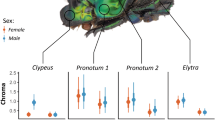Abstract
Monitor lizards prey on snakes. Conversely, venomous snakes prey on juvenile monitor lizards. Immediately after hatching, monitor lizards are naive to all prey items, thus correct assessment of snake prey is paramount for survival. Experiments were conducted to determine how hatchling monitor lizards (Varanus albigularis) with no previous exposure to snakes reacted to sympatric venomous and nonvenomous snakes. Hatchling lizards attacked harmless snakes, but avoided venomous species. Lizards readily accepted meat from skinned snakes, regardless of species. When invertebrate prey covered with skin segments from venomous snakes were restrained from moving, they were usually investigated by tongue-flicking and rejected. Unrestrained skin-covered prey, however, were generally attacked and eaten without prior evaluation by tongue-flicking. Attack was inhibited in trials in which unrestrained prey were tongue-flicked, suggesting that chemical cues contained in snake skins mediate avoidance of venomous snakes. Selection for the ability to perceive snake integumental chemicals may be especially strong in species that both consume and are consumed by snakes.
Similar content being viewed by others
References
Auffenberg, W. 1978. Social and feeding behavior inVaranus komodoensis, in pp. 301–331, N. Greenberg and P.D. MacLean (eds.). Behavior and Neurology of Lizards. U.S. Department of Health, Education, and Welfare, Washington, D.C.
Berry, H.H., andLouw, G.N. 1982. Nutritional balance between grassland productivity and large herbivore demand in the Etosha National Park.Madoqua 12:141–150.
Branch, W.R. 1988. South African Red Data Book: Reptiles and Amphibians. South African Scientific Programs Report, CSIR, Pretoria.
Branch, W.R. 1991. The Regenia registers of ‘Gogga’ Brown (1869–1909) “Memoranda on a species of monitor or Varan.”Mertensiella 2:57–110.
Burghardt, G.M. 1966. Stimulus control of the prey attack response in naive garter snakes.Psychon. Sci. 4:37–38.
Burghardt, G.M. 1968. Chemical preference studies on newborn snakes of three sympatric species ofNatrix.Copeia 1968:732–737.
Burghardt, G.M. 1970. Chemical perception in reptiles,in pp. 241–308, J.W. Johnston, D.G. Moulton, and A. Turk, (eds.). Advances in Chemoreception. Appleton-Century-Crofts, New York.
Carmer, S.G., andSwanson, M.R. 1973. An evaluation of ten pairwise multiple comparison procedures by Monte Carlo methods.J. Am. Stat. Assoc. 68:66–74.
Cooper, W.E., {jrJr.} 1989. Prey odor discrimination in the varanoid lizardsHeloderma suspectum andVaranus exanthematicus.Ethology 81:250–258.
Cooper, W.E., {jrJr.} 1990. Chemical detection of predators by a lizard, the broad-headed skink (Eumeces laticeps).J. Exp. Zool. 256:162–167.
Dial, B.E., Weldon, P.J., andCurtis, B. 1989. Chemosensory identification of snake predators (Phyllorhynchus decurtatus) by banded geckos (Coleonyx variegatus).J. Herpetol. 23:224–229.
Drummond, H. 1985. The role of vision in the predatory behaviour of natricine snakes.Anim. Behav. 1985:206–215.
Duvall, D., Chiszar, D., Hayes, W.K., Leonhardt, J.K., andGoode, M.J. 1990. Chemical and behavioral ecology of foraging in prairie rattlesnakes (Crotalus viridis viridis).J. Chem. Ecol. 16:87–101.
Halpern, M. 1987. The organization and function of the vomeronasal system.Annu. Rev. Neurosci. 10:325–362.
Halpern, M., andKubie, J.L. 1983. Snake tongue flicking behavior: Clues to vomeronasal system functions,in pp. 45–72, D. Müller-Schwarze and R.M. Silverstein (eds.). Chemical Signals in Vertebrates, Vol. 3. Plenum Press, New York.
King, D., andGreen, B. 1979. Notes on the diet and reproduction of the sand goanna,Varanus gouldii rosenbergi.Copeia 1979:64–70.
Losos, J.B., andGreene, H.W. 1988. Ecological and evolutionary implications of diet in monitor lizards.Biol. J. Linn. Soc. 35:379–407.
Pianka, E.R. 1986. The Ecology and Natural History of Desert Reptiles. Princeton University Press, Princeton University Press, Princeton, New Jersey.
Shine, R. 1986. Food habits, habitats and reproductive biology of four sympatric species of varanid lizards in tropical Australia.Herpetologica 42:346–360.
Shine, R. 1989. Constraints, allometry, and adaptation: Food habits and reproductive biology of Australian brownsnakes (Pseudonaja: Elapidae).Herpetologica 45:195–207.
Shine, R., andSlip, D.J. 1990. Biological aspects of the adaptive radiation of Australasian pythons (Serpentes: Boidae).Herpetologica 46:283–290.
Simon, C.A. 1983. A review of lizard chemoreception,in pp. 119–133, R.B. Huey, E.R. Pianka, and T.W. Schoener (eds.). Lizard Ecology: Studies of a Model Organism. Harvard University Press, Cambridge, Massachusetts.
Visser, J. 1967. Poisonous Snakes of Southern Africa and the Treatment of Snake Bite. Timmons, Cape Town.
Weldon, P.J. 1982. Responses to ophiophagus snakes by snakes of the genusThamnophis.Copeia 1982:788–794.
Weldon, P.J. 1991. Responses by vertebrates to chemicals from predators,in pp. 500–521, D. MacDonald, D. Müller-Schwarze, and S.E. Natynczuk (eds.). Chemical Signals in Vertebrates, Vol. 5. Oxford University Press, Oxford.
Weldon, P.J., andBurghardt, G.M. 1979. The ophiophage defensive response in crotaline snakes: Extension to new taxa.J. Chem. Ecol. 5:141–151.
Weldon, P.J., andSchell, F.M. 1984. Responses by king snakes (Lampropeltis getulus) to chemicals from colubrid and crotaline snakes.J. Chem. Ecol. 10:1509–1520.
Author information
Authors and Affiliations
Rights and permissions
About this article
Cite this article
Phillips, J.A., Alberts, A.C. Naive ophiophagus lizards recognize and avoid venomous snakes using chemical cues. J Chem Ecol 18, 1775–1783 (1992). https://doi.org/10.1007/BF02751102
Received:
Accepted:
Issue Date:
DOI: https://doi.org/10.1007/BF02751102




